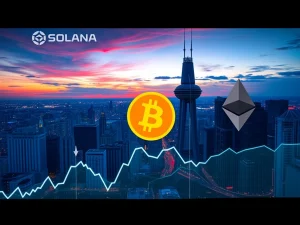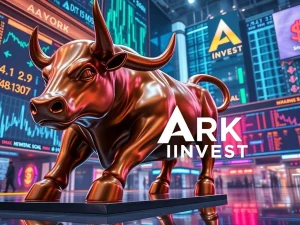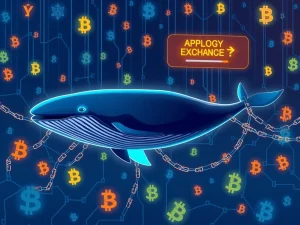Breaking: Crypto Whale Unleashes $12M Leveraged Bet on Solana and XRP via Hyperliquid

In the fast-paced world of cryptocurrency, few events capture attention quite like the moves of a major crypto whale. These colossal players, with their deep pockets and strategic maneuvers, often send ripples across the market, influencing sentiment and price action. Recently, the crypto community has been buzzing about a significant transaction that underscores the growing sophistication and institutional interest in decentralized finance (DeFi): a whale’s audacious $12 million injection into Hyperliquid, a leading decentralized derivatives platform, to open highly leveraged positions in both XRP and Solana (SOL).
Understanding the Mega-Move: How a Crypto Whale is Shaking Up the Market
This isn’t just another trade; it’s a calculated, high-stakes gamble on the short-term performance of two prominent altcoins. According to on-chain analytics from Hypurrscan, the whale deposited a substantial 11.37 million USDC to initiate these positions. The breakdown reveals a strategic allocation:
- XRP Position: $12.03 million allocated, entered at $3.17 per token for 3.77 million XRP. The liquidation price for this position is set at $1.63.
- Solana (SOL) Position: $10.68 million allocated, opened at $188.2 per token for 56,869 SOL. This position faces liquidation if SOL drops below $96.50.
Both trades employed 2x isolated leverage. For those new to the concept, leverage allows traders to amplify their exposure to an asset by borrowing funds. A 2x leverage means that for every dollar of their own capital, they control two dollars’ worth of the asset. While this can magnify potential gains, it equally amplifies potential losses, making liquidation thresholds a critical point of concern. This specific move by the crypto whale highlights a strong conviction in the upside potential of both XRP and SOL, despite the inherent risks.
Deep Dive into Hyperliquid: The Platform Facilitating High-Stakes Leveraged Trading
The choice of platform for such a significant trade is as telling as the trade itself. Hyperliquid, a decentralized derivatives exchange, stands out for its ability to facilitate high-leverage positions without the need for traditional intermediaries. Unlike centralized exchanges (CEXs) that require users to deposit funds into a custodial wallet and undergo extensive KYC (Know Your Customer) processes, decentralized platforms like Hyperliquid allow users to trade directly from their self-custody wallets.
This decentralized approach offers several key advantages, particularly for large players like institutional whales:
- Reduced Regulatory Scrutiny: By operating on a decentralized protocol, traders can often bypass the stringent regulatory frameworks and delays associated with centralized entities.
- Enhanced Privacy: Transactions are pseudo-anonymous, linked only to wallet addresses rather than personal identities.
- Efficient Execution: Decentralized exchanges often boast high throughput and low latency, ensuring rapid order execution crucial for high-frequency or large-volume trades.
- Transparency: While identities are private, all transactions are recorded on the blockchain, offering a transparent ledger of activity for on-chain analysts to track.
The fact that a major player chose Hyperliquid for such a substantial leveraged trading operation signals a growing trust in DeFi infrastructure to handle sophisticated financial strategies. This aligns with a broader trend of institutional adoption within the DeFi space, where projects are increasingly building robust, scalable solutions tailored for professional traders.
The Dual Bet: Why XRP and Solana Are in the Spotlight
The whale’s decision to concentrate capital in XRP and Solana is noteworthy. These two altcoins, while distinct in their use cases and market dynamics, represent significant segments of the crypto ecosystem:
- XRP: Often associated with cross-border payments and institutional adoption through Ripple’s network, XRP has a large, dedicated community and is frequently subject to legal and regulatory developments that can heavily influence its price. Its potential for a resolution in its ongoing legal battles could unlock significant upside.
- Solana (SOL): Known for its high throughput and low transaction fees, Solana has emerged as a formidable competitor to Ethereum, particularly in areas like NFTs, DeFi, and gaming. Despite past network outages, its developer ecosystem continues to grow, attracting significant capital and innovation.
The timing of this trade coincides with renewed macroeconomic optimism and ongoing technical developments within the altcoin space. For XRP, the liquidation threshold at $1.63 is a critical support level, indicating the whale’s belief that the price will hold above this point. Similarly, SOL’s price point at the time of the trade, around $188.2, suggests confidence in its immediate upward trajectory. This strategic bet on two distinct assets highlights a nuanced view of the market, indicating belief in their short-term performance potential.
Risks and Rewards: Navigating Leveraged Trading in DeFi
While the potential for amplified gains is attractive, leveraged trading comes with significant risks, especially in the highly volatile cryptocurrency market. The 2x leverage employed by the whale means that a relatively small price movement against their position could lead to substantial losses, or even a full liquidation of their collateral.
Consider the liquidation prices:
- If XRP falls from $3.17 to $1.63 (a drop of approximately 48.5%), the entire $12.03 million position would be liquidated.
- If Solana falls from $188.2 to $96.50 (a drop of approximately 48.7%), the entire $10.68 million position would be liquidated.
These figures underscore the precarious nature of such trades. A sudden market correction, unforeseen news, or even a broader bearish trend could trigger margin calls, potentially leading to forced selling that exacerbates market volatility. This situation contrasts with recent bearish moves by other large holders, such as a reported $9 billion Bitcoin liquidation, illustrating the fragmented and often contradictory views held by institutional players in the crypto market. The lack of detailed information on the whale’s broader portfolio strategy further complicates a full assessment of the long-term implications of this specific move.
What This Means for the Future of DeFi and Altcoins
This major transaction serves as a potent example of how institutional actors are increasingly leveraging DeFi infrastructure for high-impact trades. As decentralized platforms like Hyperliquid continue to mature, their role in facilitating large-scale, sophisticated strategies is expected to grow. This marks a significant shift from the early days of DeFi, where activity was largely dominated by retail users and smaller-scale experiments.
The move also signals confidence in the underlying technology and potential of specific altcoins like Solana and XRP. While the immediate outcome of this particular trade remains to be seen, it will undoubtedly be closely watched by market participants. The success or failure of such a prominent leveraged position could influence broader sentiment, particularly concerning the viability of decentralized derivatives and the future price trajectories of these key assets. Investors are advised to monitor these positions closely, as their outcomes could shape near-term market dynamics and provide insights into the evolving landscape of institutional crypto adoption.
The actions of a single crypto whale can often provide a glimpse into the prevailing sentiment and strategic directions within the market. This bold move on Hyperliquid, involving substantial leveraged bets on XRP and Solana, highlights both the immense opportunities and the inherent risks present in the decentralized finance space. It’s a testament to the growing maturity of DeFi platforms that they can now handle such large-scale institutional maneuvers, further blurring the lines between traditional finance and the crypto world. As the market continues to evolve, keeping an eye on these significant transactions will remain crucial for understanding the forces at play.
Frequently Asked Questions (FAQs)
What is a crypto whale?
A crypto whale is an individual or entity that holds a very large amount of cryptocurrency. Their significant holdings mean that their trades, whether buying or selling, can have a substantial impact on market prices and overall sentiment.
What is Hyperliquid?
Hyperliquid is a decentralized derivatives exchange that allows users to trade perpetual futures contracts with high leverage directly from their non-custodial wallets. It operates on a blockchain, offering transparency and often lower fees compared to centralized exchanges, while minimizing regulatory friction.
What does ‘2x isolated leverage’ mean?
2x isolated leverage means that for every dollar of your own collateral, you are borrowing an additional dollar to double your exposure to a trade. ‘Isolated’ means that only the collateral specifically allocated to that position is at risk of liquidation, not your entire wallet balance.
What are the risks associated with leveraged trading on platforms like Hyperliquid?
The primary risk is amplified losses. While leverage can magnify gains, it also magnifies losses. If the market moves against a leveraged position, even by a small percentage, it can lead to a margin call or even full liquidation of the collateral, resulting in significant financial loss. Volatility in crypto markets further exacerbates these risks.
Why did the whale choose XRP and Solana for this trade?
The specific reasons are speculative, but XRP is often favored for its potential in cross-border payments and its large community, while Solana is known for its high transaction speed and growing ecosystem in DeFi and NFTs. The whale likely sees short-term upside potential in both assets, possibly influenced by recent technical developments or market sentiment.
How can investors track or react to such whale movements?
Investors can use on-chain analytics tools (like Hypurrscan, as mentioned in the article) to track large transactions. While reacting directly to every whale move is risky due to market volatility, understanding these trends can provide insights into market sentiment and potential support/resistance levels. It’s crucial for investors to conduct their own research and not solely rely on the actions of large players.










